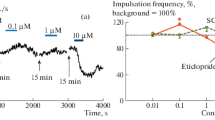Summary
The action of glutamate on frog ampullar receptors was investigated to assess the potential role of this excitatory amino acid as an afferent transmitter in the hair cell system. Intracellular recordings from single afferent units in the isolated labyrinth revealed that glutamate and the glutamate receptor agonists, N-methyl-D-aspartic acid, quisqualic acid and kainic acid increase dose-dependently the frequency of the resting afferent discharge of EPSPs and spikes and produce long lasting depolarizations. After blocking synaptic transmission by using 5 mM Co2+, the same compounds elicited only depolarizations of amplitude comparable to those observed in normal saline. Quisqualic acid and kainic acid were much more potent than N-methyl-D-aspartic acid in increasing the frequency of afferent discharge and in causing axonal depolarizations. The depolarization caused by glutamate was reduced dose-dependently by the competitive non-NMDA receptor antagonist 6-cyano-7-nitroquinaxoline-2,3 dione and disappeared almost completely in Na+-free Ringer solution. These results are consistent with the hypothesis that glutamate is the afferent transmitter in vestibular organs and indicate that receptors mainly of the non-NMDA type are present not only at postsynaptic level but also in hair cells. Presynaptic glutamate receptors may function as autoreceptors controlling by a positive feed-back mechanism the release of the afferent transmitter.
Similar content being viewed by others
References
Bledsoe SC, Bobbin RP, Puel JL (1988) Neurotransmission in the inner ear. In: Jahn AF, Santos-Sacchi (eds) Physiology of the ear. Raven Press, New York, pp 385–406
MacDermott AB, Dale N (1987) Receptors, ion channels and synaptic potentials underlying the integrative actions of excitatory amino acids. Trends Neurosci 10: 280–294
Prigioni I, Valli P, Casella C (1983) Peripheral organization of the vestibular efferent system in the frog: an electrophysiological study. Brain Res 269: 83–90
Prigioni I, Russo G, Valli P, Masetto S (1990) Pre- and postsynaptic excitatory action of glutamate agonists on frog vestibular receptors. Hearing Res 46: 253–260
Prigioni I, Russo G, Masetto S (1994) Non-NMDA receptors mediate glutamate-induced depolarization in frog crista ampullaris. Neuro Report 5: 516–518
Sarantis M, Everett K, Attwell D (1988) A presynaptic action of glutamate at the cone output synapse. Nature 332: 451–453
Valli P, Zucca G, Prigioni I, Botta L, Casella C, Guth PS (1985) The effect of glutamate on frog semicircular canal. Brain Res 330: 1–9
Watkins JC, Olvermann HS (1987) Agonists and antagonists for excitatory amino acid receptors. Trends Neurosci 10: 265–272
Author information
Authors and Affiliations
Rights and permissions
About this article
Cite this article
Prigioni, I., Russo, G. Glutamate excitatory effects on ampullar receptors of the frog. Amino Acids 9, 265–273 (1995). https://doi.org/10.1007/BF00805957
Received:
Accepted:
Issue Date:
DOI: https://doi.org/10.1007/BF00805957



